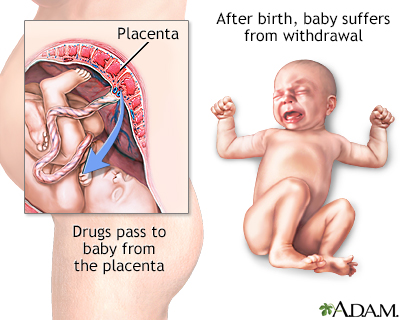It is a condition that starts in a newborn whose mother has used drugs (legal or illegal) in pregnancy. The newborn suffers from the withdrawal effects of the drugs that his/ her mother was exposed to in pregnancy before he/ she was born. Until the drugs have passed out of the baby’s system, he or she feels discomfort like an adult who suddenly stops using addictive drugs.
CAUSES
This condition called NAS may occur in a newborn when a pregnant woman takes drugs like codeine, heroin, methadone, alcohol, benzodiazepines, barbiturates and certain antidepressants (SSRIs) while in the womb. While baby is in the womb, these drugs can pass through the placenta and get delivered to the baby. The baby therefore becomes dependent on the drug along with the mother.
If the mother continues to use the drugs within the week or so before delivery, the baby will be dependent on the drug at birth.
Because the baby is no longer getting the drug after birth, withdrawal symptoms may occur as the drug is slowly cleared from the baby’s system.

Babies of mothers who use opioids and other addictive drugs (nicotine, amphetamines, cocaine, marijuana, alcohol) may have long-term problems. While there is no clear evidence of a NAS for other drugs, they may contribute to the severity of a baby’s NAS symptoms.
SIGN AND SYMPTOM
Signs and symptom of NAS depend on the type of drug the mother takes, for how long and how much. Signs and symptoms include:
- High pitched cry
- Shaky, tremor
- Cranky, restless
- Hard to keep asleep
- Overactive sucking
- Feeding problems
- Frequent stools
- Vomiting
- Yawning
- Poor weight gain
- Seizure
- Severe diaper rash
TREATMENT
Treatment depends on:
- The drug involved
- The infant’s overall health and abstinence scores (Finnegan score)
- Whether the baby was born full-term or premature
The health care team will watch the newborn carefully for up to a week (or more depending on how the baby is doing) after birth for signs of withdrawal, feeding problems, and weight gain. Babies who vomit or who are very dehydrated may need to get fluids through a vein (IV).
Infants with NAS are often fussy and hard to calm. Tips to calm them include measures often referred to as “TLC” (tender loving care):
- Gently rocking the child
- Reducing noise and lights
- Skin to skin care with mom (Kangaroo mothercare), or swaddling the baby in a blanket
- Breastfeeding (if the mother is in a methadone or buprenorphine treatment program without other illicit drug use)
Some babies with severe symptoms need medicines such as methadone or morphine to treat withdrawal symptoms and help them be able to eat, sleep and relax. These babies may need to stay in the hospital for weeks or months after birth. The goal of treatment is to prescribe the infant a drug similar to the one the mother used during pregnancy and slowly decrease the dose over time. This helps wean the baby off the drug and relieves some withdrawal symptoms.
If the symptoms are severe, such as if other drugs were used, a second medicine such as phenobarbital or clonidine may be added.
Babies with this condition often have severe diaper rash or other areas of skin breakdown. This requires treatment with special ointment or cream.
Babies may also have problems with feeding or slow growth. These babies may require:
- Higher-calorie feedings that provide greater nutrition
- Smaller feedings given more often
Further reading:
https://www.marchofdimes.org/complications/neonatal-abstinence-syndrome-(nas).
https://medlineplus.gov/ency/article/007313.htm
https://www.nature.com/articles/s41572-018-0045-0
https://www.nationwidechildrens.org/conditions/neonatal-abstinence-syndrome

Dr. Adeyemo Olusola is a medical graduate of Olabisi Onabanjo University, Ogun State, Nigeria along with certificate in advanced diploma in Principles of Nutrition, Management and Leadership, Dublin and Certificate in Global Health from London School of Hygiene and Tropical Medicine. In addition to his numerous certifications, he is a certified Telemedicine Physician from Harvard Medical School, USA. He is an avid reader of books from different oases of life, expert in data analysis. “So many a time, I have seen people die avoidable death because of lack of knowledge or information, falling victim of fate. There is then a necessity laid on us to help arm our society to the teeth, as a healthy society cannot be detached from an informed one. Hence, there is need for healthgist.net. We hope you will have a wonderful stay on our website.”
